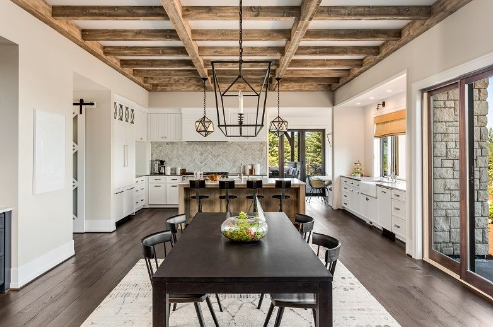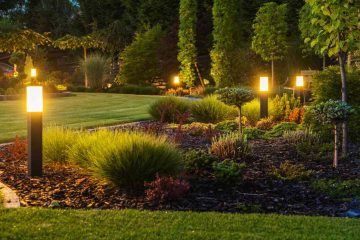Open-concept spaces have become increasingly popular in modern home design, offering a sense of spaciousness, fluidity, and connectivity that enhances the overall living experience. However, as homes age or undergo restoration, these open spaces can lose their original charm and cohesion. Restoring open-concept spaces provides an opportunity to revive their aesthetic appeal and introduce timeless materials that bring warmth, texture, and elegance to the environment. Two materials—wood and stone—can be harmonized to create a balanced and inviting atmosphere in any open-concept home. In this article, we explore how to effectively incorporate wood and stone in home restorations to enhance the beauty and functionality of open-concept spaces.
Defining Zones with Wood and Stone
One key challenge in open-concept spaces is defining distinct zones without disrupting the flow of the overall layout. Wood and stone can be used creatively to establish these zones while maintaining a cohesive design. Holly Cooper, Marketing Manager at Windows & Doors UK, emphasizes the importance of balancing materials to create visually appealing and functional spaces:
“We understand the importance of creating distinct zones in open-concept spaces while preserving unity throughout the home. Using wood flooring in living and dining areas, paired with stone tiles or slabs in kitchens or entryways, not only defines these spaces but also adds texture and variety. This careful selection of materials ensures that each area serves its purpose while contributing to the overall aesthetic.” Another effective method is to use wood and stone to highlight architectural features. Cooper adds, “Incorporating a stone accent wall or fireplace as a focal point in the living room, complemented by exposed wooden beams or ceiling paneling, can significantly enhance the space. The contrast between the cool, rugged texture of stone and the warm, smooth wood finish creates a dynamic yet harmonious interplay that elevates the home’s design.”
This approach also extends to window and door design. “Choosing the right windows and doors to complement these materials can further enhance the overall look,” Cooper explains. “For example, wood-framed windows or doors can seamlessly blend with wooden beams or flooring, while stone-surround entryways can be paired with sleek, modern door designs to create a striking entrance that sets the tone for the rest of the space.”
Blending Aesthetics: Mixing Modern and Traditional Elements
In-home restorations, it’s essential to balance modern design trends and the traditional elements that give a home its character. Wood and stone are versatile materials that seamlessly blend contemporary and classic styles. Carl Panepinto, Marketing Director at Midtown Flood Restoration, emphasizes the importance of this balance in achieving a cohesive and timeless design:
“We believe the key to a successful restoration is integrating modern design elements with the traditional features that define a home’s character. For instance, pairing sleek, polished stone countertops with rustic, reclaimed wood cabinetry in a kitchen creates a striking contrast that feels both modern and timeless. This combination updates the space and honors the home’s original aesthetic.” Similarly, in a restored living room, wooden furniture with classic craftsmanship can complement a stone fireplace with clean, minimalist lines. Panepinto adds, “carefully selecting colors, textures, and finishes is crucial to ensure that the wood and stone elements harmonize harmoniously. Lighter wood tones can be paired with darker stones to create a balanced contrast, while matching undertones in both materials can tie the design together, resulting in a cohesive look that respects the home’s history.”
“When restoring an open-concept space, consider how combining wood and stone can enhance the home’s architectural features. Panepinto advises, “Either maintaining the integrity of historical elements or introducing modern touches, thoughtful integration of wood and stone can elevate the space while preserving its unique character. This approach ensures the restored home looks beautiful and authentic to its original design.”
Enhancing Function” Quality with Durable Materials
Beyond aesthetics, the choice of materials in a home restoration project should also consider functionality and durability—especially in high-traffic, open-concept spaces. Arman Minas, Director at Armstone, emphasizes the importance of selecting materials that can withstand the demands of daily life while maintaining their beauty over time:
“We always stress the significance of choosing durable materials like wood and stone for home restorations, particularly in open-concept spaces that see a lot of use. These materials are aesthetically pleasing and incredibly resilient, making them ideal for areas where durability is paramount. Stone is particularly well-suited for kitchens, entryways, and bathrooms, where its durability and resistance to moisture make it a practical choice. Minas explains, “Stone countertops, flooring, and backsplashes in these areas are designed to endure the wear and tear of daily activities while providing a luxurious and timeless look. The natural toughness of stone and its moisture resistance make it an excellent choice for spaces that require both beauty and durability.”
On the other hand, wood is an excellent material for living areas and dining rooms, where its warmth and comfort create an inviting atmosphere. “Wood brings a natural coziness to open-concept spaces, making them feel more welcoming and lived-in,” Minas adds. “When properly maintained, wood can retain its rich finish and structural integrity for years, contributing to a space that feels both elegant and comfortable.” Proper maintenance ensures wood and stone’s long-term beauty and function in open-concept spaces. “Sealing stone surfaces can protect them from stains and moisture, ensuring they remain pristine,” Minas advises. “Similarly, regular cleaning and polishing of timber can preserve its finish and prevent damage. By choosing these durable materials and maintaining them properly, homeowners can enjoy the benefits of a restored, open-concept, beautiful, and highly functional space for years to come.”
Conclusion
Reviving open-concept spaces through home restoration offers an exciting opportunity to blend the timeless appeal of wood and stone. By using these materials to define zones, combine modern and traditional aesthetics, and enhance functionality, homeowners can create a harmonious and inviting environment that elevates the overall design of their home. Whether restoring an older property or updating a contemporary space, the thoughtful integration of wood and stone can breathe new life into open-concept areas, making them aesthetically pleasing and highly functional. With careful planning and attention to detail, these materials can help transform any open-concept space into a cohesive and beautiful living area that stands the test of time.



